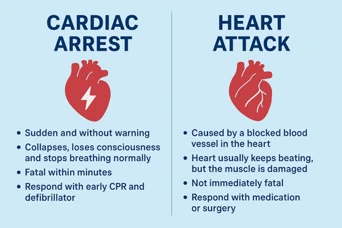Understanding Cardiac Arrest
A cardiac arrest means that the heart suddenly stops pumping. Normally, your heart beats continuously and pumps blood through your body, so your organs – especially your brain – get the oxygen they need.
Key points :
It usually happens suddenly and without warning.
The person will collapse, lose consciousness, and stop breathing normally.
Without immediate treatment, cardiac arrest is fatal within minutes.
The most effective response is early CPR (cardiopulmonary resuscitation) and the use of a defibrillator (AED) to restore the heart’s rhythm.
In a cardiac arrest, that suddenly stops:
The blood no longer circulates.
A person usually becomes unconscious right away.
Without help, the person can no longer breathe and may die within minutes.
What’s important to remember:
A cardiac arrest is always life-threatening.
Calling 112 immediately and starting CPR (chest compressions and ventilations) can make the difference.
If there’s an AED (automated defibrillator) nearby, use it – it can sometimes get the heart beating again.
It is different from a heart attack:
A heart attack is caused by a blocked blood vessel in the heart. The heart usually keeps beating, but the muscle is damaged.
A cardiac arrest is an electrical problem where the heart stops beating properly, often triggered by arrhythmias like ventricular fibrillation.

Did you know ?
It can happen to anyone.
The first responder in a cardiac arrest… is you!
Effective CPR can prevent brain stem death and preserve brain function.
Effective CPR keeps the heart in a more responsive state, allowing it to be more effective if a defibrillator is used!
Effective CPR keeps tissues alive by maintaining blood flow and delivering oxygen to the body’s cells!
Every year, over 300,000 people suffer from out-of-hospital cardiac arrest in Europe.
Only 8 to 10% of the people survive because of the lack of people knowing CPR.
About 75% of the cardiac arrests occur at home.
Starting effective CPR within 4-6 minutes after collapsing, and when possible with AED, can up the survival rates significantly!
Who is at Risk?
The simple answer: anyone.
Cardiac arrest often happens in people with heart problems, but not always. It can strike young, old, healthy, sick, all gender - people. And it doesn’t wait for the “right” time or place – it can happen at home, at work, or in public, often without warning.
What You Can Do: